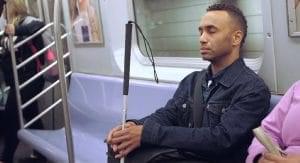
Rodney Evans is an African-American filmmaker with a good number of shorts and documentaries to his name. As a filmmaker, his sight is necessary for him to do his job. Or so he always thought. The thing is, Evans has the rare genetic disorder Retinitis pigmentosa. Abbreviated to RP, it breaks down the cells in the retina, among a host of other issues, this causes an extreme loss of peripheral vision.
Vision Portraits is Evans way of dealing with his disability. We follow him as he tells stories through film and the various treatments he tries in order to maximize the time he still has vision. Throughout his journey, he interviews some notable artists to get their perspectives on how being blind has affected their output and lives. Canadian author Ryan Knighton wrote two successful books about his blindness and teaches at Capilano University.

“…Retinitis pigmentosa…it breaks down the cells in the retina, among a host of other issues, this causes an extreme loss of peripheral vision.”
John Dugdale is a photographer who at 33 had a stroke which left him blind. While this unfortunate event left his more commercial prospects high and dry, it not deter him. To this day, Dugdale uses large format cameras and hosted several solo shows the world over.
Dancer Kayla Hamilton was brought up not believing her sight issues were an actual disability. It wasn’t until she woke up one morning and could not see out of her functioning eye that she honestly felt something was wrong. After a few procedures, Hamilton regained vision in that eye and this incident directly lead to the creation of her performance piece Nearly Sighted; which the spectators wear an eye patch during the whole production.
Evans is a rather soft-spoken and intelligent man who allows his interviewees’ work to speak for themselves. Dugdale, who insists that losing his sight was freeing in quite a few ways, still creates striking and intense photos. Hamilton’s dancing is raw and emotional. She maintains that not being able to see how ridiculous she looks up on stage, frees her to express the emotions of the routine more fully. Knighton knows that explaining to potential employers about the disability probably will mean you won’t get the job. He got lucky as his college invested in hardware and software to accommodate him.

“Dugdale, who insists that losing his sight was freeing in quite a few ways, still creates striking and intense photos.”
Vision Portraits heart lies within these stories, but its power stems from its style. The cinematography by Kjerstin Rossi and Mark Tumas is often obscured, fuzzy, out of focus, or so close it is uncomfortable. These unique shot compositions give the audience a tiny sample of what these four, and several million more people the world over, go through their entire lives. Understanding this provides the viewer with a more profound empathy for the visually impaired.
Intercut throughout the various interviews, travels, and snippets of behind the scenes work are diagrams about how the eyes work and how various issues affect vision. Interestingly, despite popular consciousness thinking that being blind is total darkness, it appears more like a bright white to most. Vision Portraits educates its audience while taking them on an emotional roller coaster with brave, engaging artists.
Vision Portraits (2019) Directed by Rodney Evans. Written by Rodney Evans. Starring Rodney Evans, Ryan Knighton, Kayla Hamilton, John Dugdale. Vision Portraits screened at the 2019 SXSW Film Festival.
9 out of 10 Gummi Bears
